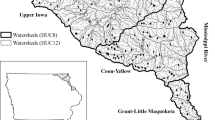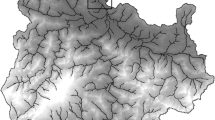Abstract
An index of biotic integrity and species richness were used to assess changes in the Presque Isle Bay watershed fish community before and after the elimination of combined sewer overflows (CSOs). The fish community was sampled with a backpack electrofisher in 2011 at 12 stream locations on 4 tributaries of Presque Isle Bay, Erie County, Pennsylvania. All sites were previously sampled in 2001. Significant increases in species richness and index of biotic integrity (IBI) scores were observed in 2011 compared to 2001. The significant increases in species richness and IBI scores occurred following the elimination of 10 CSOs to Garrison Run, 7 CSOs to Cascade Creek, and 37 CSOs to Mill Creek. Despite the increased richness and IBI scores, the fish community remains in poor condition, which may be related to the highly urbanized land use of the watershed. Urban land uses comprise 77 % of the Presque Isle Bay watershed, and in both 2011 and 2001, the watershed as a whole did not meet warm-water habitat criteria. It is unlikely that the fish community will continue to recover without addressing urbanization throughout the watershed.






Similar content being viewed by others
References
Arnold, C. L., & Gibbons, C. J. (1996). Impervious surface coverage—the emergence of a key environmental indicator. Journal of the American Planning Association, 62, 243–258.
Barbour, M. T., Gerritsen, J., Snyder, B. D., & Stribbling, J. B. (1999). Rapid bioassessment protocols for use in streams and wadeable rivers: periphyton, benthic macroinvertebrates and fish (Secondth ed.). Washington DC, US: EPA 841-B-99-002 Environmental Protection Agency, Office of Water.
Boughton, L., Benczkowski, D., Campbell, M., Carey, P., Faivre, A., Foyle, T., Grazio, J., & Grise, S. (2008). Presque Isle Bay Then & Now. Presque Isle Bay: Public Advisory Committee.
Brabec, E., Schulte, S., & Richards, P. L. (2002). Impervious surfaces and water quality: a review of current literature and its implications for watershed planning. Journal of Planning Literature, 16, 499–514.
Karr, J. R. (1981). Assessment of biotic integrity using fish communities. Fisheries, 6, 21–27.
Karr, J. R., Faush, K. D., Angermeier, P. L., Yant, P. R., & Schlosser, I. J. (1986). Assessing biological integrity in running waters: a method and its rationale. Illinois Natural History Survey Special Publication, 5.
Klauda, R., Kazyak, P., Stranko, S., Southerland, M., Roth, N., & Chailloc, J. (1998). Maryland biological stream survey: a state agency program to assess the impact of anthropogenic stresses on stream habitat quality and biota. Environmental Monitoring and Assessment, 51, 299–316.
McDonald, J.H. 2009. Handbook of Biological Statistics (2nd ed.). Sparky House Publishing, Baltimore, Maryland, pp. 198–201. http://udel.edu/~mcdonald/statsignedrank.html
Miltner, R. J., White, D., & Yoder, C. (2004). The biotic integrity of streams in urban and suburbanizing landscapes. Landscape and Urban Planning, 69, 87–100.
Morse, C. C., Huryn, A. D., & Cronan, C. (2003). Impervious surface area as a predictor of the effects of urbanization on stream insect communities in Maine, USA. Environmental Monitoring and Assessment, 89, 95–127.
Ohio, E. P. A. (1987). Biological criteria for the protection of aquatic life Volume I. The role of biological data in water quality assessment. Columbus, OH: Division of Water Quality Monitoring and Assessment.
Ohio, E. P. A. (1992). Biological and water quality study of Riley Creek and Little Riley Creek. . Columbus OH: Division of Water Quality Planning and Assessment.
Ohio, E. P. A. (1997). Biological and water quality study of Mill Creek (Scioto River Basin) and selected tributaries. Columbus OH: Division of Surface Water.
Page, L. M., & Burr, B. M. (2011). Peterson field guide to freshwater fishes (2nd ed.). Boston, Massachusetts: Houghton Mifflin.
Paul, M. J., & Meyer, J. L. (2008). Streams in the urban landscape. Urban Ecology. Section III, 207–231.
Pyron, M., Ruffing, R. A., & Lambert, A. L. (2004). Assessment of fishes of the Presque Isle Bay watershed, Erie, PA. Northeastern Naturalist, 11, 261–272.
Schueler, T. R. (1994). The importance of imperviousness. Watershed Protection Techniques, 1, 100–111.
Simon, T.P. (1991). Development of index of biotic integrity expectations for the ecoregions of Indiana. I. Central corn belt plain. United States Environmental Protection Agency Region 5, Chicago, IL.
Trautman, M. B. (1981). The fishes of Ohio. Columbus, OH: Ohio State University Press.
Walsh, C. J., Roy, A. H., Feminella, J. W., Cottingham, P. D., Groffman, P. M., & Morgan, R. P. (2005). The urban stream syndrome: current knowledge and the search for a cure. Journal of the North American Benthological Society, 24, 706–723.
Wang, L., & Lyons, J. (2002). Fish and benthic macroinvertebrate assemblages as indicators of stream degradation in urbanizing watersheds. In T. P. Simon (Ed.), Biological Response Signatures: Indicator Patterns Using Aquatic Communities (pp. 227–249). Boca Raton, FL: CRC Press.
Wang, L., Lyons, J., Kanehl, P., & Gatti, R. (1997). Influences of watershed land use on habitat quality and biotic integrity in Wisconsin streams. Fisheries, 22, 6–12.
Wang, L., Lyons, J., Kanehl, P., Bannerman, R., & Emmons, E. (2000). Watershed urbanization and changes in fish communities in Southeastern Wisconsin streams. Journal of the American Water Resources Association, 36, 1173–1189.
Wang, L., Lyons, J., & Kanehl, P. (2001). Impacts of urbanization on stream habitat and fish across multiple scales. Environmental Management, 28, 255–266.
Werner, R. G. (2004). Freshwater fishes of the Northeastern States. Syracuse: NY, Syracuse University Press.
Wichert, G. A. (1995). Effects of improved sewage effluent management and urbanization on fish associations of Toronto streams. North American Journal of Fisheries Management, 15, 440–456.
Yoder, C. O. (1995). Incorporating ecological concepts and biological criteria in the assessment and management of urban nonpoint source pollution. In H. Schultz (Ed.), Seminar Publication: National Conference on Urban Runoff Management: Enhancing Urban Watershed Management at the Local, County, and State Levels. Cincinnati, OH: U.S EPA, Center for Environmental Research Information, EPA/625/R-95-003.
Yoder, C. O., Miltner, R. J., & White, D. (1999). Assessing the status of aquatic life designated uses in urban and suburban watersheds. In National Conference on Retrofit Opportunities for Water Resource Protection in Urban Environments Proceedings. Chicago, IL, U.S: EPA, Office of Research and Development. EPA/625/R-99/002.
Yoder, C. O., Miltner, R. J., & White, D. (2000). Using biological criteria to assess and classify urban streams and develop improved landscape indicators. In S. Minamyer, J. Dye, & S. Wilson (Eds.), National Conference on Tools for Urban Water Resources Management and Protection. Cincinnati, OH, US: EPA, Office of Research and Development. EPA/625/R-00/001.
Acknowledgments
We would like to thank the United States Environmental Protection Agency for providing the funding necessary to undertake this sampling effort (Great Lakes Restoration Initiative). In addition, we would like to thank Lori Boughton (Pennsylvania Department of Environmental Protection), Dr. Robert Light (Penn State Behrend), Dr. Michael Rutter (Penn State Behrend), Mark Kwitowski (City of Erie), and Eric Obert (Regional Science Consortium) for their support and contributions to this manuscript.
Author information
Authors and Affiliations
Corresponding author
Rights and permissions
About this article
Cite this article
Rafferty, S.D., Lybrook, J., Kaczmarek, K.M. et al. Assessing changes in the Presque Isle Bay watershed fish community using a modified index of biotic integrity: before and after the elimination of combined sewer overflows. Environ Monit Assess 185, 10459–10471 (2013). https://doi.org/10.1007/s10661-013-3344-7
Received:
Accepted:
Published:
Issue Date:
DOI: https://doi.org/10.1007/s10661-013-3344-7




